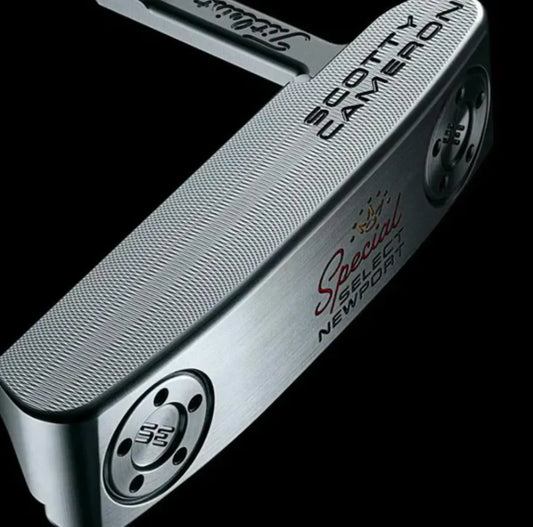Most golfers know that putters come in two distinct head shapes, mallet and blade. But what sets these two apart, and how do you know which one would be best for you? Whether you are a scratch golfer or a high handicapper, ensuring your putter is fit for your natural stroke is the most important thing.
In this comprehensive guide, we’ll explore the defining traits of mallet and blade putters to help you understand their distinctions. Ultimately, we’ll help you choose a putter that harmonizes with your natural stroke so that you can pave the way for a more accurate game.
Why You Should Choose the Right Putter Style
Choosing the right putter can drastically improve your golf game. Face-balanced putters, often called mallets, are designed for straight strokes, whereas blade putters generally accommodate arc-type strokes. However, emerging designs like double-wide blades and toe-hang mallets have blurred these lines.
Regardless of the arc stroke type, the defining difference lies in the club head shape:
- Mallet putters sport larger heads in square or half-moon shapes
- Blade putters feature sleek, thin rectangles
And remember, ensuring your putter aligns with your stroke type isn't about emulating the best players or getting the latest tech—it's about maximizing your potential on the course with consistent practice, whether at the course or on an indoor putting mat.
What Is a Mallet Style Putter?
The best putters for high handicappers are going to be mallet putters. Between blade putter and mallet putter, pros most often use the mallet putter (60% of the Top 100 PGA Tour pros, to be exact)! As previously alluded, the mallet head design is easily identifiable by its larger size and variety of shapes.
The most recognizable mallet putter head shapes are either square or half-moon. The Taylormade Spider putter is one of the most popular square shape mallet putters, whereas the Scotty Cameron GoLo7 is a well-recognized half-moon mallet putter.
Mallet putters tend to fall under the face-balanced category, but they are not exclusively so. A mallet putter can still come with a small amount of toe-hang. For those who need a forgiving putter head for off-center hits that matches their arc-style stroke, the toe-hang mallet will be your secret weapon.
What Is a Blade Style Putter?
Arguably the most recognized and well-known piece of golf technology, the blade putter is adored by golf purists. Whether it's popular putters like the iconic Scotty Cameron Newport or the historic Ping Anser, golfers of all abilities recognize this putter's head shape.
Tiger Woods, Phil Mickelson, and Jordan Spieth find the sweet spot using a blade putter. It has a much narrower clubhead, often the shape of a skinny rectangle. Blade putters tend to have the most toe-hang but are not the only style of putters that adorn this characteristic.
There are a few blade putters on the market that are, in fact, face-balanced. These are called double-wide blade putters. They look almost identical to the traditional blade putter, aside from the putter head being double the width of the traditional, hence the name.
Which Is Better: Traditional Blade or Double-Wide Blade?
When it comes to the traditional blade vs. the double-wide blade, the determining factor on which one is better is the natural shape of your putting stroke style.
Traditional Blade
The traditional blade is best for those that need the most toe-hang or like the minimalist look of the club head. Whether you need minimal or maximum toe-hang, you can find a wide array of options amongst the traditional style blade putters.
Double-Wide Blade
If you need a face-balanced putter but hate the look of mallet putters, using a double-wide face-balanced blade could be the best of both worlds, offering you both the look you want but the technology to match your stroke.
The biggest thing to remember about blade vs. mallet putters is that in order to be the best putter you can be, you need the one that matches your natural putting stroke and consistent practice with it. If you have a putter that perfectly matches your putting stroke but you never practice, no one is going to listen to your sob story about being a bad putter. Get out on the putting green, or get an indoor putting mat to practice on at home and get those reps in.
Advantages of Blade Style Putters vs. Mallet Style Putters
The way you stroke your putter will determine which style is more advantageous to you. If you are a devout member of the 80s club and are desperately seeking graduation to the elusive 70s society, consider going through a putter fitting to assess your current putter and putting stroke as well as where there might be some room for improvement via switching putter styles. Maybe it's no wonder you've been having such a hard time with distance control and aren't making enough putts!
After assessing both the current golf equipment in the bag and your putting stroke, you'll know whether you should lean into an arc-style putter using a face-balanced mallet putter or if the Scotty Cameron Newport blade really will do the trick.
Most golfers think a new putter is just what they need in order to make more putts or become the best putter at the country club. In many cases, they'd be right. But the new putter needs to fit your natural putting stroke. Otherwise, new is not always better.
There is no obvious advantage of one over the other when it comes to the blade vs. mallet putter debate. It is all relative to the individual golfer using the flat stick. Mallet putters offer the advantage of being more forgiving for newcomers because they have the least amount of club face manipulation throughout the stroke.
For those arc-stroke putters, it would not be advantageous for them to use a mallet putter as much as a blade. They need the putter face to swing open and closed naturally throughout their stroke because the putter moves on more of an arc path rather than straight back and straight through.
The real advantage comes with using a putter that matches your natural putting stroke, regardless of style and how often you practice. Having the right putter to fit your stroke is the first step. After that, it's up to you to get the reps needed to ensure you're cleaning out all your buddies' wallets next Sunday.
How PrimePutt Can Help
Both blade and mallet putters offer unique features depending on the type of putting stroke you go for. As we've said, the best way to see results when you line up to the golf ball on the green is to know your stroke and perfect it beforehand. A quality indoor putting mat like PrimePutt provides a number of benefits and a great opportunity to practice your game from the convenience of your home or office. Just keep at it!
Frequently Asked Questions
Here are some frequently asked questions customers consider when deciding between blade vs. mallet putters.
What should I consider when shopping online for the perfect putter?
There are tons of great putters out there, but the most important factor when shopping would be whether a toe-hang or face-balanced putter head is what you need to match your putting stroke properly. After that, it's important to like the look of your putter and have the proper length as well. Grip size is a preference and can always be changed after purchase.
What kind of putter do the pros use?
You name a major manufacturer of putters, and it's used on the PGA Tour. The pros use putters that best match their putting strokes needs, but 60% of the Top 100 pros are known to use mallet putters.
Is a blade or mallet putter more forgiving?
The mallet putter tends to be the more forgiving of the two putter head styles.
Which putter is going to help me make more putts, a mallet or a blade putter?
This is dependent upon which style best suits your putting stroke. The good thing is both putter head styles offer options in the face-balanced and toe-hang categories. Once you know the balance needed for your natural putting stroke, it's just a matter of finding a putter shape that fits your eye.





